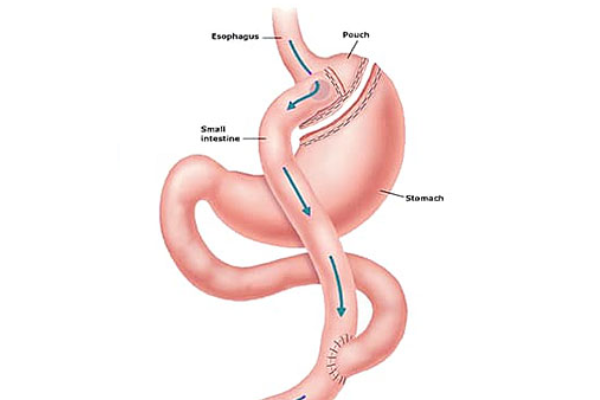
Gastric Bypass Surgery
What is Gastric Bypass Surgery?
Gastric bypass surgery has been the most frequently performed type of surgery in USA where the greatest number of obesity surgery is performed in the world, for the last 30 years. The bypass technique used has changed over years. Today, the regulation of the digestion system through gastric bypass surgery is extremely effective and safe procedure provided that it is performed by experienced bariatric surgeons. For the suitable candidates, the gains from this surgery are many times more than its risks.
Gastric bypass is a combined procedure involving both volume restrictive and absorption reducing effects. The first step of the operation is separating a small part with a volume of 30 to 35 ml of the stomach on the upper section of it through a stapler creating a smaller and newer pouch of stomach. This way, the feel of being full up is ensured with a small amount of food.
The second step of the operation is bypassing the small intestines. Namely, the remaining part of the stomach and small intestines are bypassed. This part continues its function of conveying the enzymes such as gastric acid, bile and pancreatic fluids, which play a role in digestion. The newer part of the stomach created is anastomosed to a small intestine segment which is located about 150 to 200 cm below, which means that a part of the food taken is eliminated without being absorbed.
What provides the main metabolic strength of the surgery is another mechanism. Certain hormones which are excreted by the last part of the small intestine and called incretin, has an action parallel. Furthermore it provides support to insulin which adjusts the blood glucose. At the same time, the hormones which give the feeling of fullness and diminish the appetite are excreted by this part.
The Package Includes:
- Doctor Fees for first and follow-up examinations
- Orthopedic Surgeon fees w. assistant surgeon
- Pre-op consultation with anesthesiologist, endocrinology, pulmonology, cardiology, nutrition specialist and psychologist, bloodwork, ECG, cardiac echo and lung graphy
- Pre-op gastroscopy and abdomen ultrasound
- Operating Room Charges
- Accomodation for up to 3 nights in the surgical floor including; Standard Room, Nursing Service Charges, Regular Menu Food Charges for patient and 1 accompanying person.
- Medical equipment and supplies for the procedure and procedure-related medications
- E-consultation with the surgeon in the post-up period in the home country
How does gastric bypass work?
Just like the other types of obesity surgery, we perform the gastric bypass surgery by laparoscopic method, namely by entering through an incision of only 4 mm without opening up your stomach. The duration of the operation is 3 to 4 hours. Of course, this may vary depending on the anatomy and surgical history of the patient. The average length of stay in hospital is 3 to 4 days.
How much weight is lost after gastric bypass surgery?
Gastric bypass surgery is a highly powerful weapon in your fight against obesity. Most of the patients loses 65 to 90 % of their overweight within the first year of the operation. Gastric bypass operation also provides perfect results in the treatment of the co-morbid diseases associated with obesity, which mainly include type 2 diabetes, hypertension, sleep apnoea, high cholesterol and acid reflux. Slow-down of weight loss or even re-gain of the lost weight is possible in this surgery, as in the other operations, when the patients do not follow the healthy diet and our advices about regular exercise.
When the absorption of calories is reduced, the absorption of some other important nutrients is also reduced. The bypassed part of the small intestine accounts for the absorption of the calcium, folic acid, iron and B vitamins. To prevent serious health problems, you should avoid vitamin and mineral deficiencies and take personalised vitamin-mineral supplements after bypass surgery.
What is the recovery period after surgery? How soon can I travel back home?
About 7-10 days. We recommend dietitian and psychologist follow up to our patients for at least 2 years after surgery.
Robot-Assisted Gastric Bypass Surgery
Surgical treatment is the most effective treatment method with proven effectiveness in the treatment of severe obesity patients and treatment-resistant type 2 diabetes patients. All obesity and metabolic surgery operations can be performed with minimally invasive methods (laparoscopic and robotic).
ROBOT-ASSISTED SURGERY, which is not available in every center and can only be used by a small number of surgeons, is superior to laparoscopic surgery in many ways. Robotic surgery is a surgical technique that can use techniques and equipment that minimally damage tissues in surgical interventions. Robotic surgery has all the benefits of laparoscopic surgery, such as less pain, short hospital stay, and good cosmetic results. The cosmetic results of robotic surgery are excellent.
Operation
Robotic surgery can also be considered as an advanced laparoscopic surgery. The basic operating principles are similar to laparoscopic surgery. First, 4-5 8 mm holes are opened in the abdominal wall and the abdomen is inflated with carbon dioxide gas to create an area for the study. Then, special robotic arms, which are specially designed for robotic surgery and prevent damage to the abdominal wall, are attached to these holes. Surgery is performed with the help of these arms with high mobility. A high-resolution camera is attached to one of the holes. This camera transmits the surgical images both to the console where the surgeon performs the operation and to a large monitor located at the head of the operating bed.
After this stage, the 1st surgeon leaves his place to an experienced assistant, goes to a special console designed for him, and performs the surgery with the commands he gives from there. The surgical console is the unit where all the settings related to the robot are made. The surgeon performs the surgery using special hand tools. The movements of the surgeon are reflected in the arms of the robot, and the surgery is performed thanks to the fine movements of the robot arms and the ability to work easily in narrow spaces.
Last Stage
The three-dimensional and high-quality image of the robotic camera gives the surgeon the feeling of operating with his naked eyes. In fact, thanks to the magnified image, it allows to see more clearly even the structures that the human eye can hardly see. The wrist part of the robotic arms has the ability to work similarly to the human wrist. In fact, with its high degree of mobility, it has more mobility than the human wrist. Even in tight spaces, many difficult surgical procedures can be easily performed with the robot thanks to this mobility. Since these instruments are also powerful instruments, they provide ease of operation, especially in overweight (obese) patients. With all the above-mentioned features, robotic surgery enables the surgeon to perform surgical procedures with high accuracy and precision.
To summarize, robotic surgery, which offers all the possibilities of modern technology, can be safely used in the surgical treatment of morbid obesity and type 2 diabetes.
The Package Includes:
- Doctor Fees for first and follow-up examinations
- Orthopedic Surgeon fees w. assistant surgeon
- Pre-op consultation with anesthesiologist, endocrinology, pulmonology, cardiology, nutrition specialist and psychologist, bloodwork, ECG, cardiac echo and lung graphy
- Pre-op gastroscopy and abdomen ultrasound
- Operating Room Charges
- Accomodation for up to 3 nights in the surgical floor including; Standard Room, Nursing Service Charges, Regular Menu Food Charges for patient and 1 accompanying person.
- Medical equipment and supplies for the procedure and procedure-related medications
- E-consultation with the surgeon in the post-up period in the home country
Doctor Involved In: Abdulcabbar Kartal

